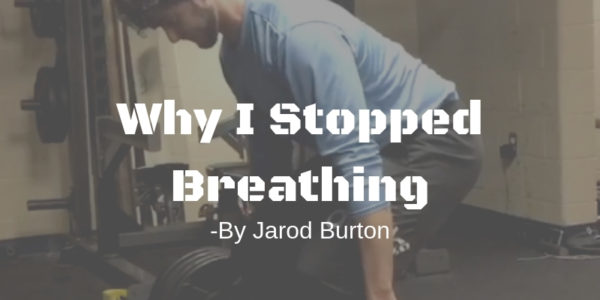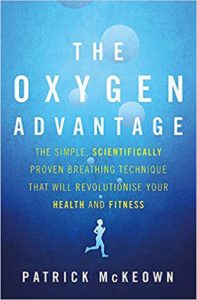This article will be in reference to the book “The Oxygen Advantage” by Patrick McKeown. None of these are my ideas but rather a general summary of the book, followed by some practical applications for you at the end.
While visiting Cal Dietz in August of 2018, he briefly mentioned that he would occasionally tape his athlete’s mouths shut during their workout. Initially, this sounded crazy to me and I thought this method might be a little too extreme. I had a few questions: “Does forcing an athlete to breathe out of their nose really provide a training advantage”? and “Is there really a right and wrong way to breathe, and if so, does it matter that much”?
During high stress environments many athletes, including myself, have been told to breathe in through your nose and out of your mouth. Typically, on the exhale, we’re told to breathe out slower than we inhale. Whether this is correct or not is not the focus. Rather, the focus is on whether the way you breathe affects your autonomic nervous system. It’s no secret that people perform tasks better when they’re in a parasympathetic (relaxed) state rather than a sympathetic (stress) state. Further, there is plenty of research that proves the faster the body can switch between a stressed state and a relaxed state, the quicker the individual will be able to recover. As a result, the faster an athlete can relax, the quicker they can recover after a training day or game. In addition, the athletes body will be able to handle higher loads of stress in future training.
Early in the book, McKeown creates a list of the benefits of incorporating the Oxygen Advantage program into your training and the negative effects that occur when you neglect the training.
Neglecting to learn how to breathe only through your nose causes the following:
- A reduction of carbon dioxide in the blood
- Mouth breathing and underutilization of the gas nitric oxide
- Impaired release of oxygen from red blood cells (based off Bohr Effect.)
- Constriction of the smooth muscle in the blood vessels and airways
- Adverse effects on blood pH
- Reduced oxygenation of working muscles and organs, including the heart and brain
- Increased acidity and fatigue during exercise
- Limited sports performance
- Negative effects to overall health
While Incorporating the Oxygen Advantage program into your training benefits the following:
- Improved sleep and energy
- Easier breathing with reduced breathlessness during exercise
- Naturally increasing the production of EPO and red blood cells
- Improving oxygenation of working muscles and organs
- Reduction of lactic acid buildup and fatigue
- Improved running economy and VO2 max
- Improved aerobic performance
- Improved anaerobic performance
- Emphasized abdominal breathing. This is crucial because it assists with lymphatic drainage. The lymphatic system is effectively the body’s sewerage system, draining away waste materials and excess fluid. As the lymphatic system does not have a heart to pump the waste throughout the body, it is reliant on the motions of the muscles, including the diaphragm. During abdominal breathing, lymph is sucked through the bloodstream, neutralizing and destroying dead cells, reducing fluid retention, and improving detoxification of the body (see article on lymphatic system here).
After looking over the list I was intrigued, but still skeptical. My initial questions were still not answered and I was still thinking in terms of an athlete. How much could this really help? Nevertheless, I eventually decided to change, or at least try to change, the way I breathe. If nothing else, it would prove to myself that it didn’t really matter whether I breathed via my nose or mouth.
This resulted in taping my mouth shut while I worked out (until I learned how to control my breathing without tape), and also while I slept at night. I wanted to tape my mouth shut throughout the day but I figured I would scare the other students at my university. However, I made an emphasis to only breathe through my nose when walking around during the day and tried to breathe so softly that no one around me could hear my breathing. In addition to all of this, I began the Oxygen Advantage training program.
This program was brought about due to discoveries from McKeown that one of the largest problems people have is that they hyperventilate daily. A quote:
“There are two main aspects to the way you breathe: the rate or number of breaths you take in the space of 1 minute and the volume or amount of air drawn into your lungs with each breath. Although the two are separate, one generally influences the other. The volume of each breath of air we inhale and exhale is measured in liters, and measurements are usually taken over 1 minute. In conventional medicine the accepted number of breaths a healthy person takes during that minute is 10 to 12, with each breath drawing in a volume of 500 milliliters of air, for a total volume of 5 to 6 liters…But over breathing doesn’t just come from an elevated rate. A lower rate can have the same effect if the individual is taking in too much air with each breath; 10 large breaths of 1,000 milliliters would also be evidence of over breathing.”
Further, a study, which was included in the book, was done in Greece where they examined the results of how the volume of air people breathe in affects electrocardiogram results. During the study, a total of 474 healthy volunteers with no apparent heart disease were put through an exercise protocol that led to an increased breathing rate of more than 30 breaths per minute for 5 minutes. This qualified them as hyperventilating. What was interesting was that this hyperventilation was not the focus of the study. Breathing patterns were simply a metric they were tracking. But they found that the hyperventilation they experienced during exercise brought about abnormalities elsewhere, that put hyperventilation on par with some diseases.
Measuring Your Breathing
McKeown uses a baseline test called Body Oxygen Level Test, or BOLT score, to determine if an individual is over breathing. A BOLT score under ten seconds is horrible and a bolt score of above 40 is where elite navy seal divers are at. Being a college baseball player, I figured my score wouldn’t be great, but that it also wouldn’t be terrible. However, when I first preformed the evaluation, I barely lasted three seconds and afterwards I was gasping for air as if I had just hiked a mountain. At this moment, it hit me that the diaphragm is a muscle and that it should be trained. Over the course of 2 months of applying the Oxygen Advantage Program into my training, I’ve brought my bolt score up to 20 seconds. Provided below is the instructions of how to test your BOLT score.
To determine your BOLT score:
- Take a normal breath in through your nose and allow a normal breath out through your nose.
- Hold your nose with your fingers to prevent air from entering your lungs.
- Time the number of seconds until you feel the first definite desire to breathe, or the first stresses of your body urging you to breathe. These sensations may include the need to swallow or a constriction of the airways. You may also feel the first involuntary contractions of your breathing muscles in your abdomen or throat as the body gives the message to resume breathing. (Note that BOLT is not a measurement of how long you can hold your breath but simply the time it takes for your body to react to a lack of air.)
- Release your nose, stop the timer, and breathe in through your nose. Your inhalation at the end of the breath hold should be calm.
- Resume normal breathing.
Please be aware of the following important points when measuring your BOLT score:
- The score is taken after a gentle exhalation.
- The breath is held until the breathing muscles first begin to move. You are not measuring the maximum time that you can hold your breath.
- If you do not feel the first involuntary movements of your breathing muscles, then release your nose when you feel the first definite urge or first distinct stress to resume breathing.
- The BOLT is not an exercise to correct your breathing.
- If you need to take a big breath at the end of the breath hold, then you have held your breath for too long.
Application for the Anaerobic Athlete
Regardless of whether you’re an aerobic or anaerobic athlete, learning how to apply hypoxia training to your current training can have a positive effect on your general health and sports training. For the purposes of this article, I’m going to primarily focus on how hypoxia training can benefit anaerobic athletes. McKeown’s methods of eliminating excessive breathing follows the principles of the Bohr Effect. If you remember from your anatomy class, Bohr’s effect is “the way in which oxygen is released from hemoglobin and delivered to the muscles and organs.” McKeown describes this perfectly here:
“The crucial point to remember is that hemoglobin releases oxygen when in the presence of carbon dioxide. When we over breathe, too much carbon dioxide is washed from the lungs, blood, tissues, and cells. This condition is called hypocapnia, causing the hemoglobin to hold on to oxygen, resulting in reduced oxygen release and therefore reduced oxygen delivery to tissues and organs. With less oxygen delivered to the muscles, they cannot work as effectively as we might like them to. As counterintuitive as it may seem, the urge to take bigger, deeper breaths when we hit the wall during exercise does not provide the muscles with more oxygen but effectively reduces oxygenation even further. In contrast, when breathing volume remains nearer to correct levels, the pressure of carbon dioxide in the blood is higher, loosening the bond between hemoglobin and oxygen and facilitating the delivery of oxygen to the muscles and organs. John West, author of Respiratory Physiology, tells us that “an exercising muscle is hot and generates carbon dioxide, and it benefits from increased unloading of O2 [oxygen] from its capillaries.” The better we can fuel our muscles with oxygen during activity, the longer and harder they can work. In light of the Bohr Effect, over breathing limits the release of oxygen from the blood, and in turn affects how well our muscles are able to work.”
One of the most common things you see among power lifters and other weightlifters is that they will take in a big gulp of air before preforming a heavy lift to help bring more oxygen to their muscles. However, according to the Bohr effect they are limiting their oxygen supplies to their muscles and tissues because oxygen is only released to our muscles and tissues with a rise in carbon dioxide. For a long time, the primary way that trainers used this method to train their athletes is through elevation training or illegal blood doping. However, by incorporating breath holding techniques known as Hypoxia training, we can provide the same results as high altitude training. Originally, I thought that hypoxia training was only important for aerobic athletes. But the reason that athletes travel to high altitudes is because it increases Erythropoietin (EPO). EPO is a hormone secreted from the kidney when the body notices a reduction in oxygen levels in the blood. One of the functions of the hormone is to” stimulate the maturation of red blood cells in the bone marrow, thereby increasing oxygen delivery to muscles”. In result, hypoxia training releases the hormone EPO which may produce somewhat similar results when compared to what we see with blood doping.
Despite my preconceived notions, hypoxia training benefits anaerobic athletes just as much as aerobic athletes. Studies have shown that hypoxia training can reduce stress and fatigue of working muscles, improve recovery time, and reduce lactic acid. In result, an aerobic athlete will be able to maintain a higher average power output. This is crucial because by incorporating hypoxia training in with anaerobic athletes, we can increase vo2 max and muscular endurance without having the athlete participate in cardiovascular endurance training. In addition, hypoxia training combined with high intensity training can have greater benefits for anaerobic athletes. The book looks at a study done at the University of Exeter in the UK. The study conducted was to determine if high-intensity sprint training or low intensity endurance training would have a greater increase on VO2 max. The study concluded that “post trial results showed that the high-intensity group experienced faster VO2 kinetics and an increased tolerance of high-intensity exercise. This means that the athletes experienced faster oxygen uptake when transitioning between rest and exercise, allowing them to perform at a higher standard more easily”. This would help athletic performance by:
- Improved anaerobic and aerobic energy supplying systems, allowing for greater endurance, strength, speed, and power
- Faster VO2 kinetics, allowing the blood to carry more oxygen to the muscles
- Increased tolerance to high-intensity exercise
- Decreased recovery time from less than maximum exercise
- Reduced lactic acid buildup
- Improved oxygenation of active muscles, allowing you to exercise harder and longer
Therefore, an athlete should start with correcting their breathing. Once the athlete reaches an adequate BOLT score, working hypoxia training into their workouts, as part of a complete and comprehensive program, may provide positive benefits.
If you’ve determined your BOLT score was under 20 seconds, I highly recommend reading the book and incorporating the breath holding drills into your training. For now, if your BOLT score was under 20 seconds, here are some things you should be conscious about:
BOLT score of 10 seconds or under:
- Nose-breathe at all times
- Avoiding sighing and taking big breaths
- Breathe Light to Breathe Right during rest
- Breathing Recovery Exercise to unblock the nose (see below)
Breathing Recovery Nose Unblocking Exercise
Perform a series of small breath holds following these instructions:
- Take a small, silent breath in and out through your nose.
- Hold your breath for 2 to 5 seconds.
- After each breath hold, breathe normally for around 10 seconds. Do not interfere with your breathing.
- Continue to do a small breath hold followed by normal breathing for around 10 seconds.
- Practice this exercise for at least 15 minutes.
BOLT score of 10 to 20 seconds:
- Nose-breathe at all times
- Avoiding sighing and taking big breaths
- Breathe Light to Breathe Right during rest and physical exercise
- Nose unblocking exercise (see below)
Nose Unblocking Exercise
- Take a small, silent breath in through your nose and a small, silent breath out through your nose.
- Pinch your nose with your fingers to hold your breath.
- Walk as many paces as possible with your breath held. Try to build up a medium to strong air shortage, without overdoing it.
- When you resume breathing, do so only through your nose. Try to calm your breathing immediately.
- After resuming your breathing, your first breath will probably be bigger than normal. Make sure that you calm your breathing as soon as possible by suppressing your second and third breaths.
- You should be able to recover normal breathing within 2 or 3 breaths. If your breathing is erratic or heavier than usual, you have held your breath for too long.
- Wait 1 or 2 minutes before repeating the breath hold.
- In order to prepare yourself for the longer breath holds, go easy for the first few repetitions, increasing your paces each time.
- Repeat for a total of 6 breath holds, creating a fairly strong need for air.
In conclusion, you should focus on breathing out of your nose always (night and day) and resist your urge to sigh throughout the day.
From the book:
“One sigh taken every few minutes is enough to maintain chronic over breathing, so it is necessary to counteract the sigh by swallowing or holding the breath. If you notice your sighs only after they have taken place, then hold your breath for 10 to 15 seconds to help compensate for the loss of carbon dioxide.”
In addition, adding these simple breathing exercises into your daily routine will help you increase your BOLT score, VO2 max, reduce lactic acid build up, and increase recovery time, allowing you to produce more power over a longer duration of time.
One last thing: if you decide to incorporate some of these methods into your training you may initially notice that your nose feels more congested and that your weight room numbers slightly drop. However, as your body adapts to it’s new, more efficient breathing pattern, these factors will return back to normal.
If you’ve somehow made it to the end of this article, I congratulate you. If you have further questions about the article, I’d love to hear them! I can be reached via email at jarodburton2105@gmail.com. Thanks for reading!

Jarod Burton is currently interning at DAC Baseball. He is in his senior year of college, studying exercise science, at Cornerstone University. In the future, he plans to continue his involvement in sports related research and biomechanics as he strives to improve the training community.

